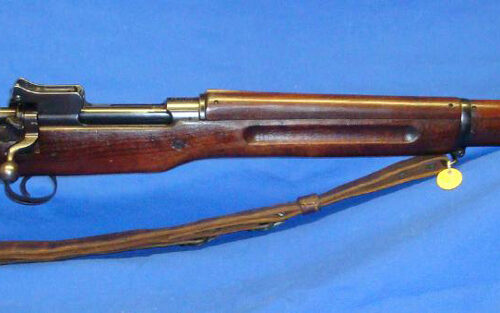The Springfield Armory Model 1866 Rifle – Second Allin Conversion and the Wagon Box Fight (Part 2/2)
Following the Civil War, Army Ordnance sought a cost effective way of altering the large inventory of serviceable .58 caliber muzzle-loading rifle-muskets into breech-loading rifles chambered for a self-primed metallic cartridge. Springfield Armory Master Armorer, Erskine S. Allin was assigned that task. He developed a design to cut open the breech of old rifle-musket barrels and attach a “trapdoor” hinged breech mechanism for loading, firing and ejecting the cartridge.
His first successful attempt was adopted as the “U.S. Rifle, Model 1865 Rifle-Musket” which utilized a .58 caliber rim fire metallic cartridge. This rifle was also known as the First Allin Conversion. Over 5,000 were produced by Springfield Armory. Field reports indicated problems sufficient to warrant a re-design.
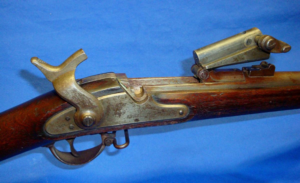
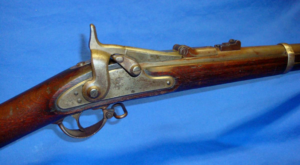 Allin’s next design employed a U-shaped spring extractor and a .50 caliber centerfire cartridge, which became known as the .50-70. That rifle was adopted as the “U.S. Rifle, Model 1866”, also known as the Second Allin conversion. This was a far simpler system, using the same Civil War era rifle-musket parts but required fewer new manufacture parts. The reduction in caliber was obtained by reaming, sleeving and rifling old rifle-musket barrels. The weapon was tested and found to be a considerably improvement over its predecessor. Nearly 50,000 were produced by Springfield Armory. It remained in service until it was phased out by the Model 1868 rifle, which utilized a new “trapdoor” type receiver with barrel screwed into that receiver, also chambered in .50-70.
Allin’s next design employed a U-shaped spring extractor and a .50 caliber centerfire cartridge, which became known as the .50-70. That rifle was adopted as the “U.S. Rifle, Model 1866”, also known as the Second Allin conversion. This was a far simpler system, using the same Civil War era rifle-musket parts but required fewer new manufacture parts. The reduction in caliber was obtained by reaming, sleeving and rifling old rifle-musket barrels. The weapon was tested and found to be a considerably improvement over its predecessor. Nearly 50,000 were produced by Springfield Armory. It remained in service until it was phased out by the Model 1868 rifle, which utilized a new “trapdoor” type receiver with barrel screwed into that receiver, also chambered in .50-70.
The rate of fire of the old M1861 Rifle-Musket was 2 to 3 rounds per minute. The rate of fire for the new M1866 Rifle increased to 8 to 10 rounds per minute. And the soldier did not have to stand up to reload, exposing himself to enemy fire. He could reload from prone while protected by hard cover. That was a game changer. By 1867 U.S. Army troops in the West were mostly armed with the M1866 rifle.
Included in being armed with the new M1866 rifle were those troops stationed at Fort Phil Kearny. In early July 1867 a wood cutting detachment left that fort to begin laying in a supply of firewood for the upcoming winter. Contractors erected a large corral of overturned wagon boxes on an open plain in between the sites of the wood cutting operations. This corral served as a field headquarters and central collection area for the wood. It was also a secure area in which livestock would be protected from night raids by Indians and it stood as a defensive enclosure from which to repel an attack.
On August 2, 1867 the Army took a measure of payback for the Fetterman Massacre. About 32 soldiers and civilians were inside the wagon box corral when Indians of several combined tribes attacked. Estimates of the number of attackers vary from several hundred to 1,000. Those soldiers and civilians were armed with M1866 rifles and a few Henry rifles. After the troops fired their first volley, the Indians moved in to press the attack, thinking that they would catch them standing and reloading. That did not go so well. It is believed the about 60 Indians were killed and 120 were severely wounded. The actual count is unknown as Indians generally took their dead and wounded when they retreated. Army Ordnance was successful in arming soldiers with a superior longarm.
The superiority of the M1866 rifle and the lever-action Henry rifles with which some civilians were armed carried the day. Had they still been armed with the M1861 rifle-musket the outcome would have certainly been the same as Fetterman’s. To quote from the excellent book The Wagon Box Fight – An Episode of Red Cloud’s War by Jerry Keenan “…the Wagon Box Fight was as much tonic to the U.S. Army as the Fetterman Fight had been to the Indians.”
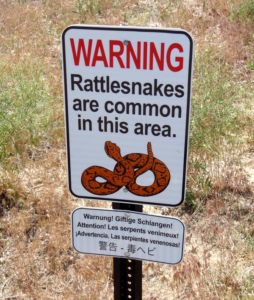
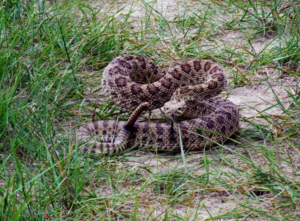
CAUTIONARY NOTE: If you visit these battle sites in Northwest Wyoming or in Montana beware of rattlesnakes. The rest areas along I-90 in Montana have signage calling attention to this issue. Mark Goodwin, author of U.S. Infantry Weapons in Combat (available on our website), encountered a very large rattlesnake on the trail to the Fettermen Monument. It was set in full ready-to-strike position and would not yield the trail. Mark had to go around; same situation on his return. Be safe.
BY SCOTT DUFF

